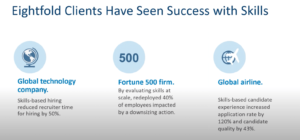Most of the talent field agrees that job descriptions are either poorly written, or just plain ineffective ways of attracting, finding, and selecting people.
An alternative is to hire people based on skills.
Eightfold talked about an alternative, hiring people based on their skills, in a recent webinar.

With this approach, you would:
Find people by skills and not job description. Eightfold’s AI shows that there are 1.4 million skills. A company can use that library of skills to select the skills it wants, and find people who have those skills. The job description can say “I’m looking for these skills” instead of the traditional vagaries like, “We’re looking for a passionate go-getter who’s a team player.”
Evaluate based on skills. When evaluating a candidate, a company can determine what skills are “validated”; what skills a person has not listed in their resume but they’re likely to have; and what skills a candidate appears to not have.
Show candidates why they should apply. On a career site, a job seeker can upload a resume and see how their skills match open positions (as opposed to what almost always goes on with career sites: finding jobs you don’t fit for, and not finding jobs you do fit for). Check out the “get matched” section on the right at Air Asia’s career site to get a feel for this.
Give employees the tools to move internally. So often, when people want a new challenge, they find it at a new company. But often, there is a job internally that’s open that the employee fit for, but wasn’t aware of. Sure, the employee may have seen a job listing, but didn’t even think their skills were a fit. Focusing on skills changes the game.
As an aside, skills can help people find contingent work, internally. So often a company goes out to find a temp worker or contractor who could have been found internally, if only the company realized someone with those skills were right there in its own workforce.
Benchmark and plan for the future. Even some of the more forward-thinking companies lack the information they need when it comes to workforce planning. They want to plan for the next three to five years, know the skills they need to get from point A to point B, but have no idea what skills their workforce currently has, and how that compares to competitors. Using AI to analyze the skills of a company’s workforce allows it to see where it’s ahead and where it’s behind, and then work on reskilling.










